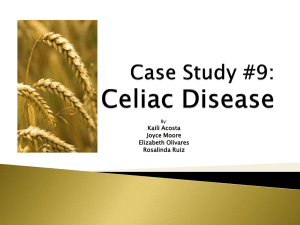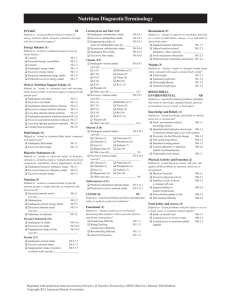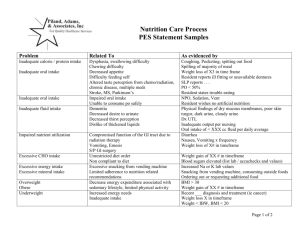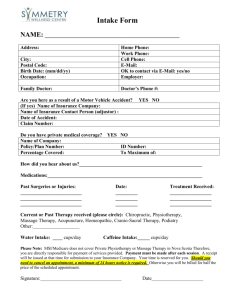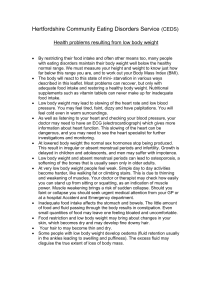Nutrition Diagnosis Etiology Matrix
advertisement
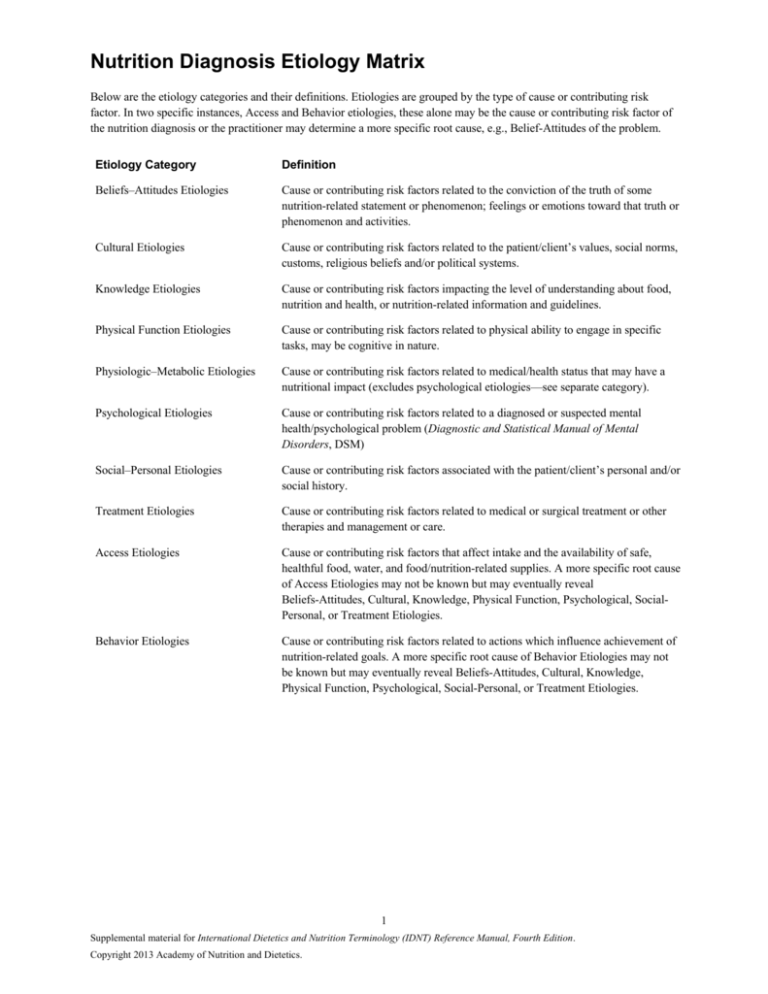
Nutrition Diagnosis Etiology Matrix Below are the etiology categories and their definitions. Etiologies are grouped by the type of cause or contributing risk factor. In two specific instances, Access and Behavior etiologies, these alone may be the cause or contributing risk factor of the nutrition diagnosis or the practitioner may determine a more specific root cause, e.g., Belief-Attitudes of the problem. Etiology Category Definition Beliefs–Attitudes Etiologies Cause or contributing risk factors related to the conviction of the truth of some nutrition-related statement or phenomenon; feelings or emotions toward that truth or phenomenon and activities. Cultural Etiologies Cause or contributing risk factors related to the patient/client’s values, social norms, customs, religious beliefs and/or political systems. Knowledge Etiologies Cause or contributing risk factors impacting the level of understanding about food, nutrition and health, or nutrition-related information and guidelines. Physical Function Etiologies Cause or contributing risk factors related to physical ability to engage in specific tasks, may be cognitive in nature. Physiologic–Metabolic Etiologies Cause or contributing risk factors related to medical/health status that may have a nutritional impact (excludes psychological etiologies—see separate category). Psychological Etiologies Cause or contributing risk factors related to a diagnosed or suspected mental health/psychological problem (Diagnostic and Statistical Manual of Mental Disorders, DSM) Social–Personal Etiologies Cause or contributing risk factors associated with the patient/client’s personal and/or social history. Treatment Etiologies Cause or contributing risk factors related to medical or surgical treatment or other therapies and management or care. Access Etiologies Cause or contributing risk factors that affect intake and the availability of safe, healthful food, water, and food/nutrition-related supplies. A more specific root cause of Access Etiologies may not be known but may eventually reveal Beliefs-Attitudes, Cultural, Knowledge, Physical Function, Psychological, SocialPersonal, or Treatment Etiologies. Behavior Etiologies Cause or contributing risk factors related to actions which influence achievement of nutrition-related goals. A more specific root cause of Behavior Etiologies may not be known but may eventually reveal Beliefs-Attitudes, Cultural, Knowledge, Physical Function, Psychological, Social-Personal, or Treatment Etiologies. 1 Supplemental material for International Dietetics and Nutrition Terminology (IDNT) Reference Manual, Fourth Edition. Copyright 2013 Academy of Nutrition and Dietetics. Category Etiology Diagnosis Beliefs-Attitudes Altered body image Poor nutrition quality of life (NB-2.5) Beliefs-Attitudes Food preference Limited food acceptance (NI-2.9), Excessive fat intake (NI-5.6.2), Less than optimal intake of types of fats (specify) (NI-5.6.3), Undesirable food choices (NB-1.7) Beliefs-Attitudes Denial of need to change Not ready for diet/lifestyle change (NB-1.3) Beliefs-Attitudes Desire for a cure for a chronic disease through the use of alternative therapy Unsupported beliefs/attitudes about food or nutrition-related topics (NB-1.2) Beliefs-Attitudes Disbelief in science-based food and nutrition information Unsupported beliefs/attitudes about food or nutrition-related topics (NB-1.2) Beliefs-Attitudes End-of-life care if patient/client or family do not desire nutrition support Less than optimal enteral nutrition composition or modality (NI-2.5), Less than optimal parenteral nutrition composition or modality (NI-2.8) Beliefs-Attitudes Familial, societal, biological/genetic, and/or environmental related obsessive desire to be thin Disordered eating pattern (NB-1.5) Beliefs-Attitudes Food faddism Imbalance of nutrients (NI-5.5), Excessive protein intake (NI-5.7.2), Less than optimal intake of types of proteins or amino acids (specify) (NI5.7.3), Excessive mineral intake (NI-5.10.2) Beliefs-Attitudes Limited food acceptance due to food aversion Inadequate oral intake (NI-2.1), Limited food acceptance (NI-2.9), Beliefs-Attitudes Unsupported beliefs/attitudes about food, nutrition, and nutrition-related information Excessive energy intake (NI-1.3), Inadequate oral intake (NI-2.1), Excessive oral intake (NI-2.2), Limited food acceptance (NI-2.9), Excessive alcohol intake (NI-4.3), Imbalance of nutrients (NI5.5), Excessive fat intake (NI-5.6.2), Less than optimal intake of types of fats (specify) (NI-5.6.3), Excessive protein intake (NI-5.7.2), Less than optimal intake of types of proteins or amino acids (specify) (NI-5.7.3), Excessive fiber intake (NI5.8.6), Excessive mineral intake (NI-5.10.2), Underweight (NC-3.1), Suboptimal growth rate (NC-3.5), Food- and nutrition-related knowledge deficit (NB-1.1), Not ready for diet/lifestyle change (NB-1.3), Limited adherence to nutrition-related recommendations (NB-1.6), Physical inactivity (NB-2.1), Excessive physical activity (NB-2.2), Limited access to food or water (NB-3.2) Beliefs-Attitudes Irritability Breastfeeding difficulty (NC-1.3) Beliefs-Attitudes Lack of self-efficacy for making change or demoralization from previous failures at change Not ready for diet/lifestyle change (NB-1.3), Limited adherence to nutrition-related recommendations (NB-1.6), Poor nutrition quality of life (NB-2.5) Beliefs-Attitudes Lack of confidence in ability to change Limited adherence to nutrition-related recommendations (NB-1.6) 2 Supplemental material for International Dietetics and Nutrition Terminology (IDNT) Reference Manual, Fourth Edition. Copyright 2013 Academy of Nutrition and Dietetics. Category Etiology Diagnosis Beliefs-Attitudes Lack of value for behavior change or competing values Excessive energy intake (NI-1.3), Excessive oral intake (NI-2.2), Excessive alcohol intake (NI-4.3), Excessive fat intake (NI-5.6.2), Less than optimal intake of types of fats (specify) (NI-5.6.3), Selfmonitoring deficit (NB-1.4), Limited adherence to nutrition-related recommendations (NB-1.6), Physical inactivity (NB-2.1), Inability or to manage self-care (NB-2.3) Beliefs-Attitudes Lacks motivation and or readiness to apply or support systems change Undesirable food choices (NB-1.7) Beliefs-Attitudes Negative impact of current or previous medical Poor nutrition quality of life (NB-2.5) nutrition therapy (MNT) Beliefs-Attitudes Not ready for diet/lifestyle change Overweight, adult or pediatric (NC-3.3.1), Obese, pediatric (NC-3.3.2), Obese, Class I (NC-3.3.3), Obese, Class II (NC-3.3.4), Obese, Class III (NC3.3.5), Self-monitoring deficit (NB-1.4), Inability to manage self-care (NB-2.3), Poor nutrition quality of life (NB-2.5) Beliefs-Attitudes Perception of inadequate milk supply Breastfeeding difficulty (NC-1.3) Beliefs-Attitudes Perception that lack of resources (e.g., time, financial, or interpersonal) prevent: Beliefs-Attitudes • Selection/food choices consistent with recommendations Undesirable food choices (NB-1.7) • Changes Not ready for diet/lifestyle change (NB-1.3), Limited adherence to nutrition-related recommendations (NB-1.6) • Sufficient level of activity Physical inactivity (NB-2.1) • Self-monitoring Self-monitoring deficit (NB-1.4), Inability to manage self-care (NB-2.3) Unwilling or disinterested in: • Learning/applying information Food- and nutrition-related knowledge deficit (NB1.1), Not ready for diet/lifestyle change (NB-1.3), Limited adherence to nutrition-related recommendations (NB-1.6), Undesirable food choices (NB-1.7), Inability to manage self-care (NB-2.3) • Reducing energy intake Excessive energy intake (NI-1.3) • Reducing intake Excessive oral intake (NI-2.2) • Modify protein or amino acid intake Less than optimal intake of types of proteins or amino acids (specify) (NI-5.7.3) • Tracking progress Self-monitoring deficit (NB-1.4) • Unwillingness to purchase or consume fiber-containing foods Inadequate fiber intake (NI-5.8.5) • Weight regulation/preoccupation significantly influences self-esteem Disordered eating pattern (NB-1.5) 3 Supplemental material for International Dietetics and Nutrition Terminology (IDNT) Reference Manual, Fourth Edition. Copyright 2013 Academy of Nutrition and Dietetics. Category Etiology Diagnosis Cultural Culture of overeating Predicted excessive energy intake (NI-1.5) Cultural Practices that affect nutrient intake Predicted suboptimal nutrient intake (specify) (NI5.11.1) Cultural Cultural practices that affect ability to: Knowledge • Access to food, fluid, nutrients Inadequate energy intake (NI-1.2), Inadequate oral intake (NI-2.1), Inadequate fluid intake (NI-3.1), Malnutrition (NI-5.2), Inadequate protein–energy intake (NI-5.3), Inadequate protein intake (NI5.7.1), Inadequate carbohydrate intake (NI-5.8.1), Inadequate vitamin intake (specify) (NI-5.9.1), Inadequate mineral intake (specify) (NI-5.10.1), Unintended weight loss (NC-3.2) • Make appropriate food choices Inadequate fat intake (NI-5.6.1) • Breastfeed Breastfeeding difficulty (NC-1.3) • Learn/apply information Food- and nutrition-related knowledge deficit (NB-1.1), Undesirable food choices (NB-1.7) • Manage self-care Inability to manage self-care (NB-2.3) • Reduce carbohydrate intake Excessive carbohydrate intake (NI-5.8.2) • Regulate types of protein or amino acids consumed Less than optimal intake of types of proteins or amino acids (specify) (NI-5.7.3) • Regulate timing of carbohydrate consumption Inconsistent carbohydrate intake (NI-5.8.4) • Regulate types of carbohydrate consumed Less than optimal intake of types of carbohydrate (specify) (NI-5.8.3) • Track personal progress Self-monitoring deficit (NB-1.4) Food and nutrition knowledge deficit Inadequate energy intake (NI-1.2) , Excessive energy intake (NI-1.3), Excessive oral intake (NI2.2), Inadequate fluid intake (NI-3.1), Excessive fluid intake (NI-3.2), Suboptimal bioactive substance intake (NI-4.1), Excessive bioactive substance intake (NI-4.2), Excessive alcohol intake (NI-4.3), Malnutrition (NI-5.2), Inadequate protein–energy intake (NI-5.3), Imbalance of nutrients (NI-5.5), Excessive fat intake (NI-5.6.2), Inadequate protein intake (NI-5.7.1), Excessive protein intake (NI-5.7.2), Inadequate carbohydrate intake (NI-5.8.1), Inadequate fiber intake (NI5.8.5), Excessive mineral intake (specify) (NI5.10.2), Overweight, adult or pediatric (NC-3.3.1), Obese, pediatric (NC-3.3.2), Obese, Class I (NC3.3.3), Obese, Class II (NC-3.3.4), Obese, Class III (NC-3.3.5), Excessive growth rate (NC-3.6), Selfmonitoring deficit (NB-1.4), Inability to manage self-care (NB-2.3), Poor nutrition quality of life (NB-2.5), Limited access to food or water (NB3.2), Limited access to nutrition-related supplies (NB-3.3) 4 Supplemental material for International Dietetics and Nutrition Terminology (IDNT) Reference Manual, Fourth Edition. Copyright 2013 Academy of Nutrition and Dietetics. Category Etiology Diagnosis Knowledge Food and nutrition knowledge deficit concerning: • Sufficient oral food/beverage intake Inadequate oral intake (NI-2.1) • Consumption of an appropriate variety of foods Excessive mineral intake (specify) (NI-5.10.2) • Potentially unsafe food Intake of unsafe food (NB-3.1) • Proper infant feeding, food/feeding preparation and storage Intake of unsafe food (NB-3.1) • Adequate energy intake Underweight (NC-3.1) • Appropriate amount or types of dietary protein or amino acids Malnutrition (NI-5.2), Inadequate protein–energy intake (NI-5.3), Inadequate protein intake (NI5.7.1), Less than optimal intake of types of proteins or amino acids (specify) (NI-5.7.3) • Appropriate amount or type of dietary fat Inadequate protein–energy intake (NI-5.3), Inadequate fat intake (NI-5.6.1), Excessive fat intake (NI-5.6.2), Less than optimal intake of types of fats (specify) (NI-5.6.3) • Appropriate amount and types of dietary carbohydrate Excessive carbohydrate intake (NI-5.8.2), Less than optimal intake of types of carbohydrate (specify) (NI-5.8.3) • Appropriate timing of carbohydrate intake Inconsistent carbohydrate intake (NI-5.8.4) • Physiological causes requiring careful timing and consistency in the amount of carbohydrate Inconsistent carbohydrate intake (NI-5.8.4) • Physiological causes requiring use of modified carbohydrate Less than optimal intake of types of carbohydrate (specify) (NI-5.8.3) • Physiological causes requiring use of modified carbohydrate intake Excessive carbohydrate intake (NI-5.8.2) • Desirable quantities of fiber Inadequate fiber intake (NI-5.8.5), Excessive fiber intake (NI-5.8.6) • Correct enteral formula needed Inadequate enteral nutrition infusion (NI-2.3) • Food and supplemental sources of vitamins Inadequate vitamin intake (specify) (NI-5.9.1), Excessive vitamin intake (specify) (NI-5.9.2) • Food and supplemental sources of minerals Inadequate mineral intake (specify) (NI-5.10.1) • Recommended dose of vitamin and mineral supplements Imbalance of nutrients (NI-5.5) • Management of diagnosis requiring mineral restriction Excessive mineral intake (specify) (NI-5.10.2) • Management of diagnosed genetic disorder altering mineral homeostasis Excessive mineral intake (specify) (NI-5.10.2) 5 Supplemental material for International Dietetics and Nutrition Terminology (IDNT) Reference Manual, Fourth Edition. Copyright 2013 Academy of Nutrition and Dietetics. Category Knowledge Etiology Diagnosis Food and nutrition knowledge deficit, cont’d: • Correct amount of enteral/parenteral formula Excessive energy intake (NI-1.3) Excessive parenteral nutrition infusion (NI-2.7) • Correct parenteral nutrition components Inadequate parenteral nutrition infusion (NI-2.6), Less than optimal parenteral nutrition composition or modality (NI-2.8) • Appropriate/correct access for delivering EN/PN Inadequate enteral nutrition infusion (NI-2.3), Inadequate parenteral nutrition infusion (NI-2.6) • Health benefits of physical activity Physical inactivity (NB-2.1) • How to make nutrition-related changes Limited adherence to nutrition-related recommendations (NB-1.6) • Food-drug interactions Food-medication interaction (NC-2.3), Predicted food-medication interaction (NC-2.4) • On the part of the caregiver Excessive enteral nutrition infusion (NI-2.4), Excessive parenteral nutrition infusion (NI-2.7), Less than optimal enteral nutrition composition or modality (NI-2.5), Less than optimal parenteral nutrition composition or modality (NI-2.8) • Consumption of high-dose nutrient supplements Imbalance of nutrients (NI-5.5) • Infant/child hunger cues Food- and nutrition-related knowledge deficit (NB1.1) Lack of prior exposure or exposure to inaccurate nutrition-related information Food- and nutrition-related knowledge deficit (NB1.1), Unsupported beliefs/attitudes about food or nutrition-related topics (NB-1.2), Self-monitoring deficit (NB-1.4), Undesirable food choices (NB1.7), Inability to manage self-care (NB-2.3) Lack of prior exposure to accurate information regarding physical activity Physical inactivity (NB-2.1) Failure to adjust for lifestyle changes or restricted mobility and decreased metabolism Excessive energy intake (NI-1.3) Physical function Irritability Breastfeeding difficulty (NC-1.3) Physical function Inability to physically: Self-feeding difficulty (NB-2.6) • Bend elbow at wrist • Grasp cups and utensils • Sit with hips square and back straight • Support neck and/or control head and neck • Coordinate hand movement to mouth Physical function Lack of self-feeding ability Unintended weight loss (NC-3.2) Physical function Diminished ability to shop Limited access to food or water (NB-3.2), Limited access to nutrition-related supplies (NB-3.3) Physical function Limited physical strength or range of motion Self-feeding difficulty (NB-2.6) Physical function Physical inactivity Overweight, adult or pediatric (NC-3.3.1), Obese, pediatric (NC-3.3.2), Obese, Class I (NC-3.3.3), Obese, Class II (NC-3.3.4), Obese, Class III (NC3.3.5), Excessive growth rate (NC-3.6) 6 Supplemental material for International Dietetics and Nutrition Terminology (IDNT) Reference Manual, Fourth Edition. Copyright 2013 Academy of Nutrition and Dietetics. Category Etiology Diagnosis Physical function Change in physical activity anticipated Predicted suboptimal energy intake (NI-1.4), Predicted excessive energy intake ( NI-1.5) Physical function Voluntary or involuntary physical activity/movement Increased energy expenditure (NI-1.1) PhysiologicMetabolic Age-related demands Inadequate protein intake (NI-5.7.1), Suboptimal growth rate (NC-3.5) PhysiologicMetabolic Alteration in gastrointestinal tract • Decreased functional length of GI tract Increased nutrient needs (specify) (NI-5.1), Malnutrition (NI-5.2), Altered GI function (NC-1.4), Suboptimal growth rate (NC-3.5) • Alteration in GI anatomical structure Increased nutrient needs (specify) (NI-5.1), Malnutrition (NI-5.2), Altered G function (NC-1.4), Inadequate fat intake (NI-5.6.1), Suboptimal growth rate (NC-3.5) • Alteration in GI function Limited food acceptance (NI-2.9), Suboptimal bioactive substance intake (NI-4.1), Excessive bioactive substance intake (NI-4.2), Increased nutrient needs (specify) (NI-5.1), Malnutrition (NI5.2), Inadequate fat intake (NI-5.6.1), Altered GI function (NC-1.4), Suboptimal growth rate (NC-3.5) • Change in GI tract motility Altered GI function (NC-1.4) • Change in GI related organ function Increased nutrient needs (specify) (NI-5.1), Altered GI function (NC-1.4), Suboptimal growth rate (NC3.5) • Compromised endocrine function Impaired nutrient utilization (NC-2.1), Suboptimal growth rate (NC-3.5) PhysiologicMetabolic Altered cholesterol metabolism/regulation Decreased nutrient needs (specify) (NI-5.4) PhysiologicMetabolic Breast or nipple abnormality Breastfeeding difficulty (NC-1.3) PhysiologicMetabolic Changes in taste, appetite Excessive fat intake (NI-5.6.2), Less than optimal intake of types of fats (specify) (NI-5.6.3) PhysiologicMetabolic Conditions leading to excess fluid loss Inadequate fluid intake (NI-3.21) PhysiologicMetabolic Craniofacial malformations Biting/Chewing (masticatory) difficulty (NC-1.2) PhysiologicMetabolic Decreased energy needs Overweight, adult or pediatric (NC-3.3.1), Obese, pediatric (NC-3.3.2), Obese, Class I (NC-3.3.3), Obese, Class II (NC-3.3.4), Obese, Class III (NC3.3.5), Excessive growth rate (NC-3.6) PhysiologicMetabolic Decreased ability to consume sufficient energy, nutrients Inadequate energy intake (NI-1.2), Inadequate oral intake (NI-2.1), Inadequate protein–energy intake (NI-5.3), Inadequate protein intake (NI-5.7.1), Inadequate vitamin intake (specify) (NI-5.9.1), Inadequate mineral intake (specify) (NI-5.10.1), Unintended weight loss (NC-3.2) ), Suboptimal growth rate (NC-3.5) 7 Supplemental material for International Dietetics and Nutrition Terminology (IDNT) Reference Manual, Fourth Edition. Copyright 2013 Academy of Nutrition and Dietetics. Category Etiology Diagnosis PhysiologicMetabolic Decreased nutrient needs related to low activity levels due to chronic disease or organ failure Excessive enteral nutrition infusion (NI-2.4), Excessive parenteral nutrition infusion (NI-2.7), Excessive vitamin intake (specify) (NI-5.9.2) PhysiologicMetabolic Decreased total fat need or recommendation Excessive fat intake (NI-5.6.2) PhysiologicMetabolic Altered fatty acid need or recommendation Less than optimal intake of types of fats (specify) (NI-5.6.3) PhysiologicMetabolic Developmental delay Limited food acceptance (NI-2.9) PhysiologicMetabolic Difficulty chewing or swallowing high-fiber foods Inadequate fiber intake (NI-5.8.5) PhysiologicMetabolic Difficulty latching on Breastfeeding difficulty (NC-1.3) PhysiologicMetabolic Excessive energy intake Overweight, adult or pediatric (NC-3.3.1), Obese, pediatric (NC-3.3.2), Obese, Class I (NC-3.3.3), Obese, Class II (NC-3.3.4), Obese, Class III (NC3.3.5), Excessive growth rate (NC-3.6) PhysiologicMetabolic Food allergies and aversions impeding food choices consistent with guidelines Undesirable food choices (NB-1.7) PhysiologicMetabolic Food intolerances Decreased nutrient needs (specify) (NI-5.4) PhysiologicMetabolic Genetic predisposition to overweight/obesity Predicted excessive energy intake (NI-1.5) PhysiologicMetabolic Heart failure Decreased nutrient needs (specify) (NI-5.4) PhysiologicMetabolic Illness causing unexpected weight gain because of head trauma, immobility, paralysis or related condition Unintended weight gain (NC-3.4) PhysiologicMetabolic Impaired cognitive ability, including learning disabilities, neurological or sensory impairment, and dementia Inadequate fluid intake (NI-3.1), Food- and nutritionrelated knowledge deficit (NB-1.1), Not ready for diet/lifestyle change (NB-1.3), Self-monitoring deficit (NB-1.4), Undesirable food choices (NB-1.7), Inability to manage self-care (NB-2.3), Impaired ability to prepare foods/meals (NB-2.4), Self-feeding difficulty (NB-2.6), Limited access to food or water (NB-3.2) PhysiologicMetabolic Inadequate energy intake Underweight (NC-3.1) PhysiologicMetabolic Inadequate milk supply Breastfeeding difficulty (NC-1.3) PhysiologicMetabolic Increased energy needs Underweight (NC-3.1) PhysiologicMetabolic Injury, condition, physical disability or limitation that reduces physical activity or activities of daily living Physical inactivity (NB-2.1) PhysiologicMetabolic Intolerance of EN/PN Inadequate enteral nutrition infusion (NI-2.3), Inadequate parenteral nutrition infusion (NI-2.6) 8 Supplemental material for International Dietetics and Nutrition Terminology (IDNT) Reference Manual, Fourth Edition. Copyright 2013 Academy of Nutrition and Dietetics. Category Etiology Diagnosis PhysiologicMetabolic Kidney, liver, cardiac, endocrine, neurologic, and/or pulmonary dysfunction Limited food acceptance (NI-2.9), Excessive fluid intake (NI-3.2), Biting/ Chewing (masticatory) difficulty (NC-1.2), Altered nutrition-related laboratory values (specify) (NC-2.2), Suboptimal growth rate (NC-3.5) PhysiologicMetabolic Lack of developmental readiness to perform self-management tasks Inability to manage self-care (NB-2.3) PhysiologicMetabolic Lethargy, sleepiness Breastfeeding difficulty (NC-1.3) PhysiologicMetabolic Limited vision Self-feeding difficulty (NB-2.6) PhysiologicMetabolic Limited food acceptance Inadequate oral intake (NI-2.1), Suboptimal growth rate (NC-3.5) PhysiologicMetabolic Liver dysfunction Decreased nutrient needs (specify) (NI-5.4), Excessive protein intake (NI-5.7.2), Less than optimal intake of types of proteins or amino acids (specify) (NI-5.7.3) PhysiologicMetabolic Loss of appetite awareness Excessive oral intake (NI-2.2) PhysiologicMetabolic Malnutrition/malabsorption Increased nutrient needs (specify) (NI-5.1), Breastfeeding difficulty (NC-1.3), Suboptimal growth rate (NC-3.5) PhysiologicMetabolic Mastitis and/or painful breasts, nipples Breastfeeding difficulty (NC-1.3) PhysiologicMetabolic Mechanical issues such as inflammation, surgery, stricture, or oral, pharyngeal and esophageal tumors, mechanical ventilation Swallowing difficulty (NC-1.1), Biting/ Chewing (masticatory) difficulty (NC-1.2) PhysiologicMetabolic Inborn errors of metabolism Less than optimal intake of types of proteins or amino acids (specify) (NI-5.7.3) PhysiologicMetabolic Metabolic abnormality Excessive protein intake (NI-5.7.2), Less than optimal intake of types of proteins or amino acids (specify) (NI-5.7.3) PhysiologicMetabolic Metabolic disorders Impaired nutrient utilization (NC-2.1) PhysiologicMetabolic Motor causes related to neurological or muscular disorders Swallowing difficulty (NC-1.1) PhysiologicMetabolic Oral pain Breastfeeding difficulty (NC-1.3) PhysiologicMetabolic Other organ dysfunction that leads to biochemical changes Altered nutrition-related laboratory values (specify) (NC-2.2) PhysiologicMetabolic Partial or complete edentulism Biting/Chewing (masticatory) difficulty (NC-1.2) PhysiologicMetabolic Physical disability Impaired ability to prepare foods/meals (NB-2.4), Limited access to food or water (NB-3.2) 9 Supplemental material for International Dietetics and Nutrition Terminology (IDNT) Reference Manual, Fourth Edition. Copyright 2013 Academy of Nutrition and Dietetics. Category Etiology Diagnosis PhysiologicMetabolic Physiologic causes requiring modified amount or timing of carbohydrate intake Excessive carbohydrate intake (NI-5.8.2), Less than optimal intake of types of carbohydrate (specify) (NI-5.8.3), Inconsistent carbohydrate intake (NI-5.8.4) PhysiologicMetabolic Physiological causes increasing nutrient needs due to: • Accelerated growth or anabolism Increased energy expenditure (NI-1.1), Inadequate enteral nutrition infusion (NI-2.3), Inadequate parenteral nutrition infusion (NI-2.6), Increased nutrient needs (specify) (NI-5.1), Inadequate mineral intake (specify)(NI-5.10.1), Suboptimal growth rate (NC-3.5) • Altered absorption or metabolism Inadequate fluid intake (NI-3.1), Increased nutrient needs (specify) (NI-5.1), Inadequate protein intake (NI-5.7.1), Inadequate carbohydrate intake (NI5.8.1), Inadequate vitamin intake (specify) (NI5.9.1), Inadequate mineral intake (specify) (NI5.10.1), Predicted suboptimal nutrient intake (specify) (NI-5.11.1), Malnutrition (NI-5.2), Inadequate protein–energy intake (NI-5.3), Unintended weight loss (NC-3.2), Suboptimal growth rate (NC-3.5) • Disease/condition Inadequate enteral nutrition infusion (NI-2.3), Inadequate parenteral nutrition infusion (NI-2.6), Inadequate fluid intake (NI-3.1), Increased nutrient needs (specify) (NI-5.1), Malnutrition (NI-5.2), Inadequate protein–energy intake (NI-5.3), Inadequate protein intake (NI-5.7.1), Less than optimal intake of types of proteins or amino acids (specify) (NI-5.7.3), Inadequate vitamin intake (specify) (NI-5.9.1), Unintended weight loss (NC3.2) ), Suboptimal growth rate (NC-3.5) • Maintenance of body temperature Increased energy expenditure ( NI-1.1), Inadequate fluid intake (NI-3.1), Suboptimal growth rate (NC3.5) • Prolonged catabolic illness Inadequate energy intake (NI-1.2), Inadequate oral intake (NI-2.1), Inadequate fluid intake (NI-3.1), Malnutrition (NI-5.2), Inadequate protein–energy intake (NI-5.3), Inadequate protein intake (NI5.7.1), Inadequate vitamin intake (specify) (NI5.9.1), Inadequate mineral intake (specify) (NI5.10.1), Unintended weight loss (NC-3.2), Suboptimal growth rate (NC-3.5) PhysiologicMetabolic Altered metabolism Predicted excessive energy intake (NI-1.5), Predicted excessive nutrient intake (NI-5.11.2) PhysiologicMetabolic Poor sucking ability Breastfeeding difficulty (NC-1.3), Suboptimal growth rate (NC-3.5) PhysiologicMetabolic Prematurity Altered nutrition-related laboratory values (NC2.2) , Suboptimal growth rate (NC-3.5) 10 Supplemental material for International Dietetics and Nutrition Terminology (IDNT) Reference Manual, Fourth Edition. Copyright 2013 Academy of Nutrition and Dietetics. Category Etiology Diagnosis PhysiologicMetabolic Renal dysfunction Decreased nutrient needs (specify) (NI-5.4), Excessive protein intake (NI-5.7.2), Less than optimal intake of types of proteins or amino acids (specify) (NI-5.7.3) PhysiologicMetabolic Small for gestational age, intrauterine growth retardation/restriction and/or lack of progress/appropriate weight gain per day Underweight (NC-3.1), Suboptimal growth rate (NC-3.5) PhysiologicMetabolic Soft tissue disease (primary or oral manifestations of a systemic disease) Biting/Chewing (masticatory) difficulty (NC-1.2) PhysiologicMetabolic Swallowing difficulty, and altered suck and breathing patterns in infants Swallowing difficulty (NC-1.1), Breastfeeding difficulty (NC-1.3) PhysiologicMetabolic Xerostomia Biting/Chewing (masticatory) difficulty (NC-1.2) Psychological Alcohol or drug addiction Excessive alcohol intake (NI-4.3), Impaired nutrient utilization (NC-2.1) Psychological Addictive personality Excessive physical activity (NB-2.2) Psychological Mental illness, confusion, or altered awareness Intake of unsafe food (NB-3.1), Excessive oral intake (NI-2.2) Psychological Psychological causes such as depression and disordered eating Inadequate energy intake (NI-1.2), Inadequate oral intake (NI-2.1), Inadequate fluid intake (NI-3.1), Excessive fluid intake (NI-3.2), Malnutrition (NI5.2), Inadequate protein–energy intake (NI-5.3), Inadequate fat intake (NI-5.6.1), Inadequate protein intake (NI-5.7.1), Inadequate carbohydrate intake (NI-5.8.1), Excessive carbohydrate intake (NI-5.8.2), Less than optimal intake of types of carbohydrate (specify) (NI-5.8.3), Inconsistent carbohydrate intake (NI-5.8.4), Inadequate fiber intake (NI-5.8.5), Inadequate vitamin intake (specify) (NI-5.9.1), Excessive vitamin intake (specify) (NI-5.9.2), Inadequate mineral intake (specify) (NI-5.10.1), Unintended weight loss, (NC-3.2) ), Suboptimal growth rate (NC-3.5), Undesirable food choices (NB-1.7), Excessive physical activity (NB-2.2), Limited access to food or water (NB-3.2), Limited access to nutritionrelated supplies (NB-3.3) Social-Personal Lack of role models Breastfeeding difficulty (NC-1.3), Physical Inactivity (NB-2.1) Social-Personal Lack of social support for implementing changes Breastfeeding difficulty (NC-1.3), Not ready for diet/lifestyle change (NB-1.3), Self-monitoring deficit (NB-1.4), Limited adherence to nutritionrelated recommendations (NB-1.6), Physical inactivity (NB-2.1), Inability to manage self-care (NB-2.3), Poor nutrition quality of life (NB-2.5) Social-Personal Family or social history of overeating Predicted excessive energy intake (NI-1.5) 11 Supplemental material for International Dietetics and Nutrition Terminology (IDNT) Reference Manual, Fourth Edition. Copyright 2013 Academy of Nutrition and Dietetics. Category Etiology Diagnosis Social-Personal Increased psychological/life stress Overweight, adult or pediatric (NC-3.3.1), Obese, pediatric (NC-3.3.2), Obese, Class I (NC-3.3.3), Obese, Class II (NC-3.3.4), Obese, Class III (NC3.3.5), Predicted suboptimal energy intake (NI1.4), Predicted excessive energy intake (NI-1.5) Social-Personal Change in living situation Predicted suboptimal energy intake (NI-1.4), Predicted excessive energy intake (NI-1.5), Predicted suboptimal nutrient intake (specify) (NI5.11.1) Social-Personal Living in a geographic location with danger for Predicted suboptimal nutrient intake (specify) (NIenvironmental emergency 5.11.1) Treatment Accidental vitamin and/or mineral overdose from oral, enteral or parenteral sources Excessive vitamin intake (specify) (NI-5.9.2), Excessive mineral intake (specify) (NI-5.10.2) Treatment Calories/kcal/kJ unaccounted for from IV infusion and/or medications Excessive energy intake (NI-1.3) Treatment Changes in taste, appetite Excessive fat intake (NI-5.6.2), Less than optimal intake of types of fats (specify) (NI-5.6.3) Treatment Changes in GI tract motility Altered GI function (NC-1.4) Treatment Chronic use of medications known to cause Unintended weight gain (NC-3.4) weight gain, such as use of certain antidepressants, antipsychotics, corticosteroids, certain HIV medications Treatment Difficulty chewing or swallowing high-fiber foods Inadequate fiber intake (NI-5.8.5) Treatment Excessive energy intake Overweight, adult or pediatric (NC-3.3.1), Obese, pediatric (NC-3.3.2), Obese, Class I (NC-3.3.3), Obese, Class II (NC-3.3.4), Obese, Class III (NC3.3.5), Treatment Food intolerances Decreased nutrient needs (specify) (NI-5.4) Treatment High level of fatigue or other side effect of therapy Undesirable food choices (NB-1.7), Impaired ability to prepare foods/meals (NB-2.4) Treatment Improvement in patient/client status, allowing Less than optimal enteral nutrition composition or return to total or partial oral diet; changes in the modality (NI-2.5), Less than optimal parenteral course of disease resulting in changes in nutrition composition or modality (NI-2.8) nutrient requirements Treatment Inadequate energy intake Underweight (NC-3.1) Treatment Infusion volume not reached or schedule for infusion interrupted Inadequate enteral nutrition infusion (NI-2.3), Inadequate parenteral nutrition infusion (NI-2.6) Treatment Insufficient electrolyte replacement when initiating feeding (PN/EN, including oral) Imbalance of nutrients (NI-5.5) Treatment Lack of, compromised, or incorrect access for delivering EN/PN Inadequate enteral nutrition infusion (NI-2.3), Inadequate parenteral nutrition infusion (NI-2.6) Treatment Mechanical issues such as inflammation, surgery, stricture, or oral, pharyngeal and esophageal tumors, mechanical ventilation Swallowing difficulty (NC-1.1), Biting/ Chewing (masticatory) difficulty (NC-1.2) 12 Supplemental material for International Dietetics and Nutrition Terminology (IDNT) Reference Manual, Fourth Edition. Copyright 2013 Academy of Nutrition and Dietetics. Category Etiology Diagnosis Treatment Medications that increase appetite Excessive energy intake (NI-1.3), Excessive oral intake (NI-2.2), Treatment Medications that increase nutrient needs Increased nutrient needs (specify) (NI-5.1) Treatment Medications that affect nutrient metabolism Impaired nutrient utilization (NC-2.1) Treatment Medications that increase fluid needs or decrease thirst Inadequate fluid intake (NI-3.1) Treatment Misused specialized protein products Less than optimal intake of types of proteins or amino acids (specify) (NI-5.7.3) Treatment Misdiagnosis of lactose intolerance/lactase deficiency Inadequate mineral intake (specify) (NI-5.10.1) Treatment Nutrient/nutrient interaction and/or drug/nutrient interaction Inadequate enteral nutrition infusion (NI-2.3), Inadequate parenteral nutrition infusion (NI-2.6), Inadequate vitamin intake (specify) (NI-5.9.1), Inadequate mineral intake (specify) (NI-5.10.1), Food-Medication Interaction (NC-2.3), Predicted food-medication interaction (NC-2.4) Treatment Overfeeding of parenteral/enteral nutrition (PN/EN) Excessive energy intake (NI-1.3) Treatment Planned procedure, therapy or medication predicted to increase energy expenditure or nutrient need Predicted suboptimal energy intake (NI-1.4), Predicted suboptimal nutrient intake (specify) (NI5.11.1) Treatment Planned therapy or medication predicted to reduce energy/nutrient need or metabolic rate/metabolism Predicted excessive energy intake (NI-1.5), Predicted excessive nutrient intake (NI-5.11.2) Treatment Planned procedure, therapy or medication predicted to decrease ability to consume sufficient energy or nutrients Predicted suboptimal energy intake (NI-1.4), Predicted suboptimal nutrient intake (specify) (NI5.11.1) Treatment Prolonged adherence to a low-fiber or lowresidue diet Inadequate fiber intake (NI-5.8.5) Treatment Prolonged hospitalization Unintended weight loss (NC-3.2) Treatment Renal dysfunction Decreased nutrient needs (specify) (NI-5.4), Excessive protein intake (NI-5.7.2), Less than optimal intake of types of proteins or amino acids (specify) (NI-5.7.3) Treatment Xerostomia Biting/Chewing (masticatory) difficulty (NC-1.2) Access Access to foods and supplements in excess of needs Excessive vitamin intake (specify) (NI-5.9.2) Access Caregiver intentionally or unintentionally not providing access to food or nutrition-related supplies Limited access to food or water (NB-3.2), Limited access to nutrition-related supplies (NB-3.3) Access Community and geographical constraints for Inadequate vitamin intake (NI-5.9.1), Limited access to food or water (NB-3.2), Limited access to nutrition-related supplies (NB-3.3) 13 Supplemental material for International Dietetics and Nutrition Terminology (IDNT) Reference Manual, Fourth Edition. Copyright 2013 Academy of Nutrition and Dietetics. Category Etiology Diagnosis Access Environmental causes, e.g., inadequately tested Inadequate vitamin intake (NI-5.9.1), Inadequate nutrient bioavailability of fortified foods, mineral intake (specify) (NI-5.10.1) beverages, and supplements; marketing of fortified foods, beverages, supplements as a substitute for natural food source of nutrient(s) Access Exposure to contaminated water or food, e.g., community outbreak of illness documented by surveillance and/or response agency Access Failure to participate in federal food programs Limited access to food or water (NB-3.2) such as WIC, National School Breakfast/Lunch Program, food stamps Access Financial constraints that may prevent sufficient level of activity (e.g., to address cost of equipment or shoes or club membership to gain access) Intake of unsafe food (NB-3.1) Physical inactivity (NB-2.1) 14 Supplemental material for International Dietetics and Nutrition Terminology (IDNT) Reference Manual, Fourth Edition. Copyright 2013 Academy of Nutrition and Dietetics. Category Etiology Access Lack of, or limited access to: Diagnosis • Adaptive foods or eating devices conducive for self-feeding Self-feeding difficulty (NB-2.6) • Available and safe exercise environment and/or equipment Physical inactivity (NB-2.1) • Fluid Inadequate fluid intake (NI-3.1), Inadequate fiber intake (NI-5.8.5) • Fortified foods and beverages Inadequate mineral intake (specify) (NI-5.10.1) • Specialized protein products Excessive protein intake (NI-5.7.2) • Food or artificial nutrition Inadequate energy intake (NI-1.2), Inadequate oral intake (NI-2.1), Malnutrition (NI-5.2), Inadequate protein-energy intake (NI-5.3), Inadequate fat intake (NI-5.6.1), Inadequate protein intake (NI5.7.1), Inadequate carbohydrate intake (NI-5.8.1), Inadequate vitamin intake (specify) (NI-5.9.1), Inadequate mineral intake (specify) (NI-5.10.1), Underweight (NC-3.1), Unintended weight loss (NC-3.2), ), Suboptimal growth rate (NC-3.5), Poor nutrition quality of life (NB-2.5) • Fiber-containing foods Inadequate fiber intake (NI-5.8.5) • Food that contains a bioactive substance Suboptimal bioactive substance intake (NI-4.1) • Healthy food choices Excessive energy intake (NI-1.3), Excessive oral intake (NI-2.2), Excessive fat intake (NI-5.6.2), Less than optimal intake of types of fats (specify) (NI-5.6.3) • Recommended foods Undesirable food choices (NB-1.7) • Sufficient quantity or variety of culturally appropriate healthful food/water Limited access to food or water (NB-3.2) • Safe and/or clear and accurately labeled food supply Excessive bioactive substance intake (NI-4.2) Intake of unsafe food (NB-3.1) • Food storage equipment/facilities Intake of unsafe food (NB-3.1) • Self-management tools or decision guides or other nutrition-related supplies Inability to manage self-care (NB-2.3), Limited access to nutrition-related supplies (NB-3.3) Access Limited, absent, or failure to participate in community supplemental food programs such as food pantries, emergency kitchens, or shelters, with a sufficient variety of culturally appropriate healthful foods or nutrition-related supplies Limited access to food or water (NB-3.2), Limited access to nutrition-related supplies (NB-3.3) Access Schools lacking nutrition/wellness policies or application of policies ensuring convenient, appetizing, competitively priced culturally appropriate healthful foods at meals, snacks, and school sponsored activities Limited access to food or water (NB-3.2) 15 Supplemental material for International Dietetics and Nutrition Terminology (IDNT) Reference Manual, Fourth Edition. Copyright 2013 Academy of Nutrition and Dietetics. Category Etiology Diagnosis Behavior Addictive behavior Excessive physical activity (NB-2.2) Behavior Consumption of high-dose nutrient supplements Imbalance of nutrients (NI-5.5) Behavior Eating behavior serves a purpose other than nourishment (e.g., pica) Unsupported beliefs/attitudes about food or nutrition-related topics (NB-1.2), Limited food acceptance (NI-2.9) Behavior Excessive energy intake Overweight, adult or pediatric (NC-3.3.1), Obese, pediatric (NC-3.3.2), Obese, Class I (NC-3.3.3), Obese, Class II (NC-3.3.4), Obese, Class III (NC3.3.5), Behavior Excessive physical activity Underweight (NC-3.1) Behavior Food and nutrition compliance limitations Excessive carbohydrate intake (NI-5.8.2), Less than optimal intake of types of carbohydrate (specify) (NI-5.8.3), Inconsistent carbohydrate intake (NI-5.8.4) Behavior Food or activity behavior-related difficulty Poor nutrition quality of life (NB-2.5) Behavior Food preparation or eating patterns that involve Excessive fiber intake (NI-5.8.6) only high-fiber foods to the exclusion of other nutrient-dense foods Behavior Disordered eating pattern Excessive physical activity (NB-2.2), Underweight (NC-3.1), Overweight, adult or pediatric (NC3.3.1), Obese, pediatric (NC-3.3.2), Obese, Class I (NC-3.3.3), Obese, Class II (NC-3.3.4), Obese, Class III (NC-3.3.5) Behavior Feeding via bottle or other route that may affect breastfeeding Breastfeeding difficulty (NC-1.3) Behavior Frequent intake of foods containing bioactive substances Excessive bioactive substance intake (NI-4.2) Behavior Limited food acceptance due to behavioral issues Inadequate oral intake (NI-2.1), Suboptimal growth rate (NC-3.5) Behavior Inability to limit or refuse offered foods Excessive oral intake (NI-2.2) Behavior Inadequate energy intake Underweight (NC-3.1) Behavior Lack of focus and attention to detail, difficulty with time management and/or organization Self-monitoring deficit (NB-1.4) Behavior Lifestyle change that reduces physical activity or activities of daily living Physical inactivity (NB-2.1) Behavior Over consumption of a limited variety of foods Excessive mineral intake (specify) (NI-5.10.2) Behavior Poor food planning, purchasing and preparation Excessive oral intake (NI-2.2), Inadequate fiber practices intake (NI-5.8.5), Limited access to food or water (NB-3.2) Behavior Reluctance or avoidance of self-feeding Self-feeding difficulty (NB-2.6) 16 Supplemental material for International Dietetics and Nutrition Terminology (IDNT) Reference Manual, Fourth Edition. Copyright 2013 Academy of Nutrition and Dietetics.
